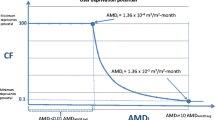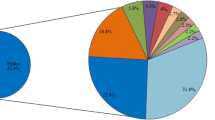Abstract
In this study, an inexact two-stage water resources allocation (ITWR) model is put forward for supporting sustainable development and management of water resources in Sanjiang Plain, China, which is in such a situation, with multi-water source, multi-water supply subarea, multi-water user and multi-planning goal. The costs of net system, water supply and recourse are analyzed. The developed ITWR model, which shows a strong ability in tacking with various uncertain factors in probability distributions and discrete interval numbers, mixes the techniques of interval-parameter programming (IPP) and two-stage stochastic programming (TSP) within a general optimization framework. And it also has formed an effective link in such a conflict between the policy scenarios and the associated various levels of economic penalties, when the pre-allocation targets of water resources are violated. Based on this model, a series of scenarios under different levels of pre-allocation water is done and different degrees of water surplus and shortage are obtained correspondingly. The results indicate that the reasonable distribution plans with maximum system benefit and minimum system-failure risk have been generated. And these results are valuable for saving water resources to realize its sustainable development and mitigating the penalty to gain economic benefits maximum, and thus some desired results are provided for decision makers in tackling with a complex and uncertain water-resource system.





Similar content being viewed by others
References
Ahmed S, Tawarmalani M, Sahinidis NV (2004) A finite branch-and bound algorithm for two-stage stochastic integer programs. Math Program Ser A 100:355–377
Bashir MA, Tanakamaru H, Tada A (2009) Spatial and temporal analysis of evapotranspiration using satellite remote sensing data: a case study in the Gezira Scheme, Sudan. J Environ Inform 13(2):86–92
Birge JR, Louveaux FV (1988) A multicut algorithm for two-stage stochastic linear programs. Eur J Oper Res 34(3):384–392
DRIZRA (2008) Design and Research Institute of Zhangweinan River Administration. Management Policy and Operation Regulation Report of Yuecheng Reservoir
Dupačová J, Gaivoronski A, Kos Z et al (1991) Stochastic programming in water management: a case study and a comparison of solution techniques. Eur J Oper Res 52(1):28–44
Fan YR, Huang GH, Guo P et al (2012) Inexact two-stage stochastic partial programming: application to water resources management under uncertainty. Stoch Env Res Risk A 26:281–293
Ferrero RW, Rivera JF, Shahidehpour SM (1998) A dynamic programming two-stage algorithm for long-term hydrothermal scheduling of multireservoir systems. Trans Power Syst 13(4):1534–1540
Gu JJ, Huang GH, Guo P et al (2013) Interval multistage joint-probabilistic integer programming approach for water resources allocation and management. J Environ Manag 128:315–624
Guo P, Huang GH, Zhu H, He L (2009) Interval-parameter two-stage stochastic semi-infinite programming application to water resources management under uncertainty. Water Resour Manag 23:1001–1023
Haugen KK (1996) A stochastic dynamic programming model for scheduling of offshore petroleum fields with resource uncertainty. Eur J Oper Res 88(1):88–100
He L, Huang GH, Zeng GM et al (2008) Wavelet-based multiresolution analysis technique for data cleaning and its application to water quality management system. Exp Syst Appl 35(3):1301–1310
Hoppe H, Weilandt M, Orth H (2004) A combined water management approach based on river water quality standards. J Environ Inform 3(2):67–76
Huang GH (1996) IPWM: an interval-parameter water quality management model. Eng Optim 26:79–103
Huang GH (1998) A hybrid inexact-stochastic water management model. Eur J Oper Res 107:137–158
Huang GH, Loucks DP (2000) An inexact two-stage stochastic programming model for water resources management under uncertainty. Civ Eng Environ Syst 17:95–118
Huang GH, Baetz BW, Patry GG (1994) Capacity planning for municipal solid waste management systems under uncertainty—a grey fuzzy dynamic programming (GFDP) approach. J Urban Plann Dev 120:132–156
Jung BS, Karnev BW, Lambert MF (2006) Benchmark tests of evolutionary algorithms: mathematic evaluation and application to water distribution systems. J Environ Inform 7(1):24–35
Li YP, Huang YP (2008) Interval-parameter two-stage stochastic nonlinear programming for water resources management under uncertainty. Water Resour Manag 22:681–698
Li YP, Huang GH, Nie SL et al (2007) ITCLP: an inexact two-stage chance-constrained program for planning waste management systems. Resour Conserv Recycl 49:284–307
Li YP, Huang GH, Yang ZF et al (2008) IFMP: interval-fuzzy multistage programming for water resources management under uncertainty. Resour Conserv Recycl 52:800–812
Li W, Li YP, Li CH (2010) An inexact two-stage water management model for planning agricultural irrigation under uncertainty. Agric Water Manag 97:1905–1914
Loucks DP, Stedinger JR, Haith DA (1981) Water resource systems planning and analysis. Prentice Hall International, Englewood Cliffs 4(3):146
Lu HW, Huang GH, Zeng GM et al (2008) An inexact two-stage fuzzy-stochastic programming model for water resources management. Water Resour Manag 22:991–1016
Lu HW, Huang GH, Lin YP et al (2009a) A two-step infinite a-cuts fuzzy linear programming method in determination of optimal allocation strategies in agricultural irrigation systems. Water Resour Manag 23(11):2249–2269
Lu HW, Huang GH, He L (2009b) Inexact rough-interval two-stage stochastic programming for conjunctive water allocation problems. J Environ Manag 91:261–269
Lu HW, Huang GH, He L (2011) An inexact rough-interval fuzzy linear programming method for generating conjunctive water-allocation strategies to agricultural irrigation systems. Appl Math Model 35:4330–4340
Luo B, Maqsood I, Huang GH (2007) Planning water resources systems with interval stochastic dynamic programming. Water Resour Manag 21(6): 997–1014
Maqsood I, Huang GH, Huang YF et al (2005) ITOM: an interval-parameter two-stage optimization model for stochastic planning of water resources systems. Stoch Env Res Risk A 19(2):125–133
Mobasheri F, Harboe RC (1970) A two-stage optimization model for design of a multipurpose reservoir. Water Resour Res 6(1):22–31
Mousavi SJ, Ponnambalam K, Karray F (2005) Reservoir operation using a dynamic programming fuzzy rule-based approach. Water Resour Manag 19(5):655–672
Oliveira C, Antunes CH (2007) Multiple objective linear programming models with interval coefficients—an illustrated overview. Eur J Oper Res 181(3):1434–1463
Olsen D, Dickson SE, Baetz B (2006) Decision support system for rural water supply in the Nilgris district of South India. J Environ Inform 7(1):1–13
Ruszczynski A (1993) Parallel decomposition of multistage stochastic programming problems. Math Program 58(2):01–28
Savic DA, Simonovic SP (1991) Selecting risk levels in chance-constrained reservoir operation modeling: a fuzzy set approach. Water Resour Manag 4(4):251–271
Słowiński R (1986) A multicriteria fuzzy linear programming method for water supply system development planning. Fuzzy Sets Syst 19(3):217–237
Trezos T, Yeh WWG (1987) Use of stochastic dynamic programming for reservoir management. Water Resour Res 23:983–996
Wang D, Adams BJ (1986) Optimization of real-time reservoir operations with Markov decision processes. Water Resour Res 22:345–352
Wang LZ, Fang L, Hipel KW (2003) Water resources allocation: a cooperative game theoretic approach. J Environ Inform 2(2):11–22
Wang X, Cui Q, Li SY (2012) An optimal water allocation model based on water resources security assessment and its application in Zhangjiakou Region, northern China. Resour Conserv Recycl 69:57–65
Xie YL, Huang GH, Li W et al (2013) An inexact two-stage stochastic programming model for water resources management in Nansihu Lake Basin, China. J Environ Manag 127:188–205
Yazenin AV (1987) Fuzzy and stochastic programming. Fuzzy Sets Syst 22(1):171–180
Acknowledgments
This research has been supported by the Special funds of innovative talents in science and technology research project of Harbin, Heilongjiang province of China (2010RFQXN102), Postdoctoral scientific research foundation of Heilongjiang Province ( LBH-Q12153), Science and technology research project of department of education of Heilongjiang province of China (12511039), and the China postdoctoral science foundation surfacefunded project (2013M531012).
Author information
Authors and Affiliations
Corresponding author
Rights and permissions
About this article
Cite this article
Zhang, L., Li, C.Y. An Inexact Two-Stage Water Resources Allocation Model for Sustainable Development and Management Under Uncertainty. Water Resour Manage 28, 3161–3178 (2014). https://doi.org/10.1007/s11269-014-0661-8
Received:
Accepted:
Published:
Issue Date:
DOI: https://doi.org/10.1007/s11269-014-0661-8




